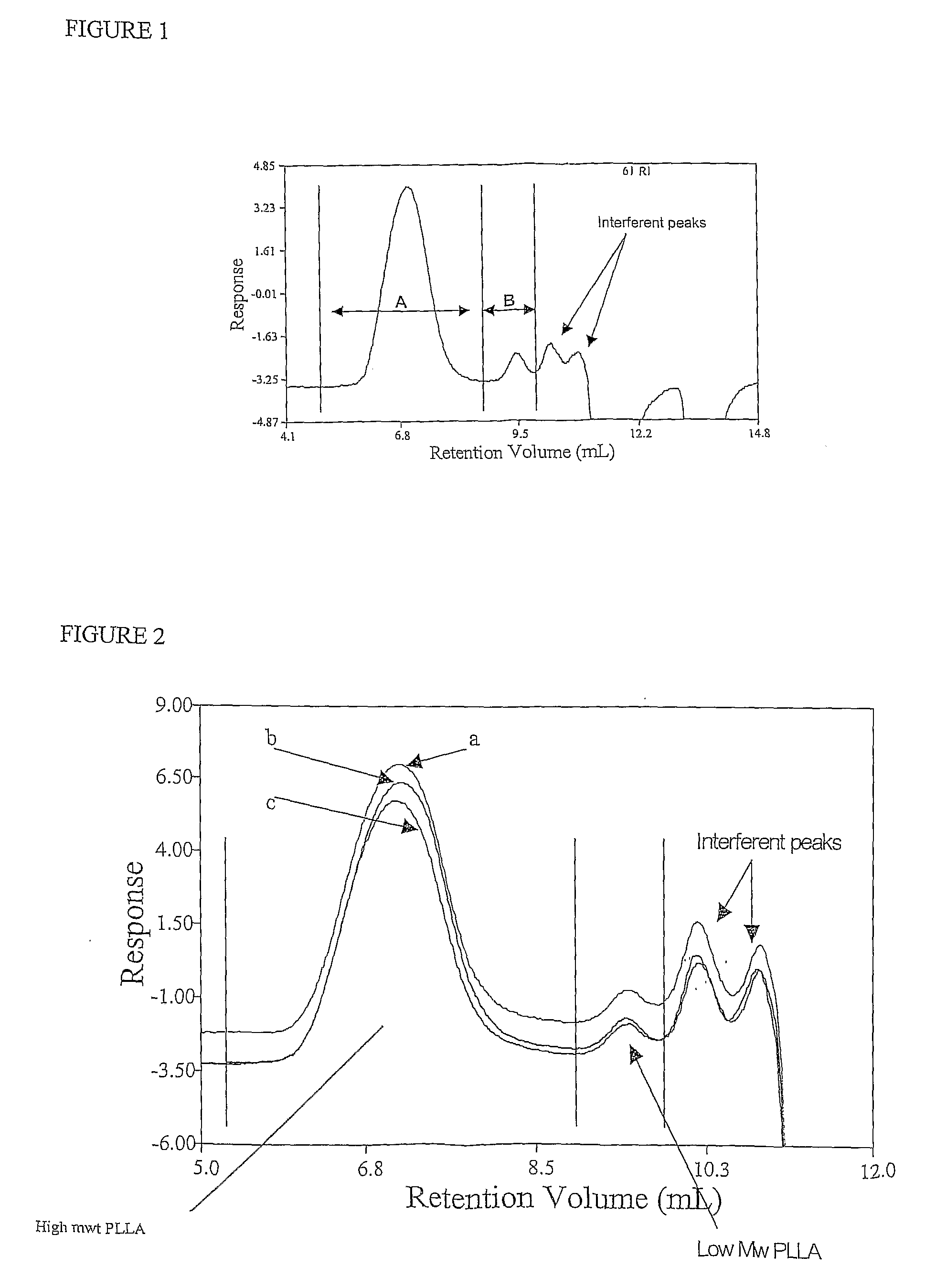Multimodal high strength devices and composites
a composite material and multi-modal technology, applied in the field of biodegradable polymeric materials, can solve the problems of insufficient strength or stiffness, inability to use materials in high load bearing applications, and more difficult processing of high-mwt polymers, so as to reduce the likelihood of scrambling
- Summary
- Abstract
- Description
- Claims
- Application Information
AI Technical Summary
Benefits of technology
Problems solved by technology
Method used
Image
Examples
example 1
Low Mwt PLLA Synthesis
[0067]PLLA was not readily commercially available in low mwt for use in the biomodal polyester production outlined in Example 2. Therefore a sample was prepared from monomer as outlined below.
Methods
[0068]Preparation of Catalyst Solution in Initiator
[0069]0.0368 g of Tin (II) chloride dihydrate and 5.00 g of di(ethyleneglycol) were weighed into a 50 ml Wheaton vial. The vial was sealed then vented using a syringe needle, and the catalyst left to dissolve in the initiator.
Preparation of Reagents
[0070]2.40 mL catalyst in initiator solution and 2.40 mL initiator were added by injection into a sealed wheaton vial containing 120 g of lactide.
Polymerisation
[0071]The sealed vial was vented and placed in a 150° C. oven. The vial was shaken periodically as the monomer melted to mix the contents. Once the monomer had completely melted, the vial was shaken to thoroughly mix the contents and the vent removed. The vial was then transferred to a 135° C. oven. After approx. 5...
example 2
Bimodal Polyester Production
[0074]A biomodal polyester was formed from a homogenous mixture of high molecular weight P(L)LA and the low molecular weight Poly-1-lactide formed in Example 1.
Methods
[0075]Purasorb® Poly-1-lactide (IV=4.51) Purac lot no 0309000996
Low molecular weight Poly-1-lactide Mn=3827 g.mol−1, Mw=5040 g.mol−1
[0076]190 g of P(L)LA IV=4 and 10 g low molecular weight P(L)LA (from Example 1) were weighed in 500 mL glass jars. The jars were agitated by hand to homogenize the powder. The contents of Jar 1 were split into 6 jars in total, and 3.10 L of CHCl3 were required to dissolve all the material. After 2 days agitation very viscous solutions were obtained. These were poured into 3 release paper trays. The jars were rinsed with a further 450 mL CHCl3 and the solutions poured into a 4th tray. The trays containing the polymer solution were placed in the fume cupboard for 24 h to dry. The polymer sheets were cut into rectangles (approx 10×6 cm) and dried in a vacuum oven...
example 3
Fibre Production
Methods
[0078]The following methodology was used to produce both P(L)LA and bimodal P(L)LA / low mwt P(L)LA blend fibres.
[0079]The polymer (or polymer blend) was extruded using a Rondol 12 mm extruder. The extruder was fitted with:—
[0080]A general-purpose 12 mm screw (with a 25:1 L / D ratio and a 3:1 compression ratio).
[0081]A 2 mm (diameter) die (coated with lubricating coating) with a L / D ratio of 6:1.
[0082]The fibre was produced using a flat temperature profile of 240° C.
Results
[0083]A nominal 0.5 mm diameter fibre was produced (using maximum screw speed of 50 rpm) and hauled off at a rate of 16 meters per minute. The diameter of the fibre was monitored during the run using a Mitutoyo laser micrometer. The extruded fibre was sealed in a foil pouch containing a desiccant sachet and then stored in a freezer at −20° C. prior to further processing.
PUM
| Property | Measurement | Unit |
|---|---|---|
| Percent by mass | aaaaa | aaaaa |
| Mass | aaaaa | aaaaa |
| Mass | aaaaa | aaaaa |
Abstract
Description
Claims
Application Information
 Login to View More
Login to View More - R&D
- Intellectual Property
- Life Sciences
- Materials
- Tech Scout
- Unparalleled Data Quality
- Higher Quality Content
- 60% Fewer Hallucinations
Browse by: Latest US Patents, China's latest patents, Technical Efficacy Thesaurus, Application Domain, Technology Topic, Popular Technical Reports.
© 2025 PatSnap. All rights reserved.Legal|Privacy policy|Modern Slavery Act Transparency Statement|Sitemap|About US| Contact US: help@patsnap.com

